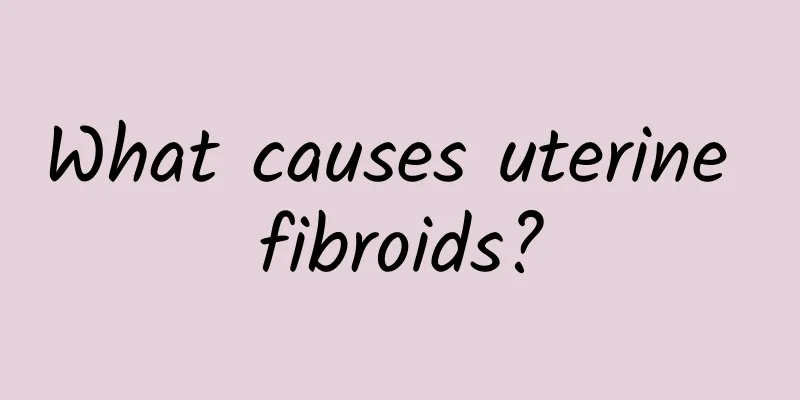What is functional uterine bleeding during puberty? 5 treatment methods

|
What is adolescent functional uterine bleeding? Here are 5 ways to regulate adolescent functional uterine bleeding. Adolescent dysfunctional uterine bleeding, also known as adolescent dysfunction, often occurs in adolescent women within a few years after menarche, especially in female students. It refers to abnormal uterine bleeding caused by neuroendocrine dysfunction of the hypothalamus-pituitary-ovarian axis. The pathological and physiological changes are manifested in that under the long-term stimulation of estrogen, the endometrium continues to grow, but to a certain extent, estrogen can no longer support the growth of the endometrium, so a similar rupture occurs. Generally speaking, menstrual disorders in adolescence are mostly caused by physiological reasons. The ovaries are non-functional in the early stage. After entering puberty, the interdependence and interaction of each link in the hypothalamus-pituitary-ovary system gradually establish the physiological function of the ovaries. Under the interaction of ovarian hormones, the endometrium undergoes periodic changes, which are manifested as regular changes in the menstrual cycle. However, for adolescent girls, since the hypothalamus-pituitary-ovary axis has not yet matured and improved, when they encounter stimulation from factors such as mental stress, overwork, and obesity. It will affect one or more links in the hypothalamus-pituitary-ovary, which may lead to ovarian failure to ovulate. Clinically, it manifests as irregular menstruation, early or late menstruation, more or less bleeding, and anemia when the amount is large. Usually, after regular and appropriate adjustment and treatment, or when the function of the hypothalamus-pituitary-ovarian axis gradually matures, menstruation will gradually return to normal. Therefore, for adolescent girls, if there is no need to rush, there is no need to rush. Although there are no obvious organic changes in adolescent dysfunctional uterine bleeding, it can present as endless bleeding or heavy bleeding. Clinically, it is mainly manifested by a significant extension of bleeding time after menstruation. In most cases, menstruation lasts about 10 days, and in some cases, it even lasts about 2 months. Due to the long bleeding time and heavy bleeding, if medical treatment is delayed, it may lead to varying degrees of anemia, which will have varying degrees of impact on study and life, and may also affect the health and growth and development of girls. Therefore, adolescent women must treat functional uterine bleeding correctly and never avoid treatment because of shyness or thinking that a little extra bleeding is no big deal. Otherwise, unnecessary harm may be caused due to delayed treatment. The primary goal of treating dysfunctional uterine bleeding is to stop bleeding and avoid anemia, shock, or even life-threatening conditions caused by massive blood loss. The second goal is to adjust the menstrual cycle to avoid bleeding again, and the third is to correct anemia in a timely manner. Drug therapy is the most commonly used method in treating dysfunctional uterine bleeding, especially for adolescent dysfunctional uterine bleeding. Drug therapy can be said to be a more appropriate treatment method. Currently, the drugs used to treat dysfunctional uterine bleeding mainly include sex hormones and non-hormonal auxiliary hemostatic drugs. Deputy Chief Physician Tan Xiaochang mentioned that dysfunctional uterine bleeding during adolescence often requires the use of hormone drugs to stop bleeding, and even after the bleeding stops, hormones are needed to regulate the cycle in the short term to guide the endocrine axis back to normal. Some mothers are worried that little girls will have adverse reactions to hormones. Director Tan believes that short-term use of hormones to regulate menstruation is more effective, and the benefits outweigh the disadvantages, so there is no need to worry too much. In addition, we also have to rely on active daily life conditioning. Only through the synergistic effect of drugs and lifestyle conditioning can we better relieve symptoms, reduce bleeding time and amount, and achieve the expected prevention and treatment goals. 1. Maintain a regular rhythm of life, have a balance between work and rest, and avoid excessive fatigue: adolescent girls should have a regular schedule every day, not be night owls, not stay up late to study or surf the Internet, and try to avoid endocrine disorders caused by irregular life and excessive fatigue, which will affect the secretion function of the hypothalamus-pituitary-ovarian axis and ultimately promote adolescent dysfunction. 2. Pay attention to emotional regulation and avoid excessive tension or mood swings: Adolescents have relatively large emotional changes. Emotional fluctuations and mental stimulation are important causes of dysfunctional uterine bleeding in adolescents. Therefore, during this period, girls should try to maintain a happy and calm state of mind. Parents should also pay more attention to their girls' emotional changes, communicate with them more, understand their inner thoughts, and help them release negative emotions to maintain a relatively stable mental state and avoid emotional fluctuations. 3. Adolescent patients with dysfunctional uterine bleeding have varying degrees of anemia due to prolonged bleeding and heavy bleeding. Therefore, it is very important to correct anemia. While taking medication, attention should be paid to strengthening nutrition, eating more iron-containing foods, such as animal offal, to ensure the demand for iron, and to ensure a balanced intake of nutrients such as protein, cellulose, and minerals. A reasonable diet is not only conducive to improving metabolism and strengthening physical fitness, but also conducive to increasing hemoglobin content and the degree of anemia. 4. Develop good hygiene habits, especially during menstruation, you should combine study with exercise and rest. Do not do strenuous exercise during menstruation, pay attention to the cleanliness of the vulva, and change underwear frequently to prevent infection. 5. Let teenagers learn more about physiological menstruation. If menstrual abnormalities occur, they should seek medical treatment in time. Do not miss the best time for treatment for fear of missing classes and affecting learning, which will eventually lead to worsening of the disease and affect the physical and mental health development of teenagers. After diagnosis, they should actively cooperate with the doctor's treatment plan, adhere to follow-up, and be completely cured. |
<<: What is an artificial vagina? What does an artificial vagina do?
>>: Treatment methods for bacterial vaginosis Bacterial vaginosis can lead to 6 complications
Recommend
Can I do eye suture implantation during menstruation?
It is not recommended to perform eye suture surge...
What is the biggest cause of uterine fibroids? What are the signs of uterine fibroids?
What is the biggest cause of uterine fibroids? Wh...
Reasons for recurrence of bacterial vaginosis in women
Nowadays, there are more and more diseases among ...
Low calories and slimming! No less than 1,200 calories per day
If you want to be healthy and slim, start by sett...
Is cervicitis serious? What kind of treatment is needed to get better?
Cervicitis was once a mild stage, but it also nee...
Is cervicitis not conducive to pregnancy? What should I do if I get pregnant?
Everyone knows that cervicitis is actually quite ...
Hollywood actresses have a secret new weapon for losing weight! Avoid these three white foods to avoid obesity
Hollywood actress Jessica Alba has a hot body. Sh...
The dangers of ovarian cysts that female friends need to pay attention to
Ovarian cysts are a gynecological disease that ha...
How to get pregnant with endometriosis
Under normal circumstances, the endometrium cover...
There are many explanations for the causes of uterine fibroid bleeding
The problem of uterine fibroid bleeding is a head...
What does uterine fibroids sonogram mean? B-ultrasound shows uterine fibroids sonogram
What does uterine fibroid sonography mean? In sho...
Will having cervical warts affect life expectancy?
A person's life span is a matter of luck and ...
Preoperative preparation for curettage of artificial abortion
The following points should be done before curett...
What medicine is used for candidal vaginitis?
Candidal vaginitis, medically known as vulvovagin...
Treatment of cervical erosion should be treated differently
Cervical erosion can be divided into many types a...









